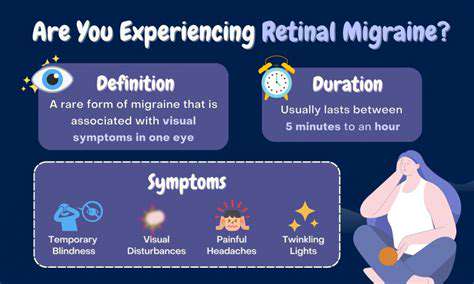
Visual Disturbances
Retinal migraines are characterized by a range of visual symptoms, often described as flashing lights, shimmering spots, or blind spots. These visual disturbances can be quite alarming, and it's important to understand that they are temporary and usually resolve within a few hours. It's crucial to distinguish these symptoms from other, more serious conditions, and seek prompt medical attention if you experience them. The visual aura is often a warning sign of an impending headache.
Some individuals may experience a gradual blurring or dimming of vision, or even temporary vision loss in part of their field of view. These visual changes can vary significantly from person to person, making proper diagnosis essential. Early recognition of these symptoms is key to managing the episode and potentially preventing future occurrences.
Headache Characteristics
Headaches are a common symptom associated with retinal migraines, and they typically occur after or alongside the visual disturbances. These headaches are often described as throbbing, pounding, or severe, and they often affect one side of the head. The pain intensity can range from mild to debilitating, depending on the individual.
The pain may be accompanied by nausea, vomiting, or sensitivity to light and sound. These accompanying symptoms can further contribute to the discomfort and impact daily activities. Understanding the specific characteristics of your headaches can be helpful in differentiating retinal migraines from other types of headaches.
Associated Symptoms
While visual disturbances and headaches are the primary symptoms, other associated symptoms can also occur. These may include neck pain, dizziness, or a feeling of pressure in the head. These additional symptoms can vary in intensity and duration and can provide further clues to the nature of the episode.
Some individuals may experience a general feeling of malaise or weakness, along with the visual and headache symptoms. These additional symptoms can often be indicative of underlying conditions that are separate from the retinal migraine. Therefore, it's essential to consider all symptoms when seeking a diagnosis.
Duration and Pattern
The duration of retinal migraine symptoms can vary widely. Visual disturbances often last for 15-60 minutes, while the headache, if present, can persist for several hours. Understanding the typical duration of your symptoms can be helpful in distinguishing retinal migraines from other, more serious conditions.
The pattern of symptoms may also be helpful in diagnosis. Some individuals experience these episodes regularly, while others experience them less frequently. Regular patterns can help in assessing the possible triggers and potential preventative measures.
Triggers and Risk Factors
Certain factors can potentially trigger retinal migraines, including stress, lack of sleep, changes in sleep patterns, skipping meals, and changes in the weather. Identifying these triggers may help in preventing future episodes. Understanding potential triggers is key to managing and potentially preventing future occurrences of retinal migraines.
Certain individuals may be more predisposed to retinal migraines due to underlying conditions or family history. It is important to discuss any potential risk factors with a healthcare professional.
When to Seek Medical Attention
If you experience recurrent visual disturbances or severe headaches, it's crucial to seek immediate medical attention. This is especially important if the symptoms are accompanied by other concerning symptoms such as weakness, numbness, or difficulty speaking. These could potentially indicate a more serious underlying condition that requires urgent medical intervention. Prompt diagnosis and treatment are essential for preventing potential complications.
It is always better to err on the side of caution and seek medical help if you have any concerns about your symptoms. A healthcare professional can evaluate your condition and provide the appropriate diagnosis and treatment plan.